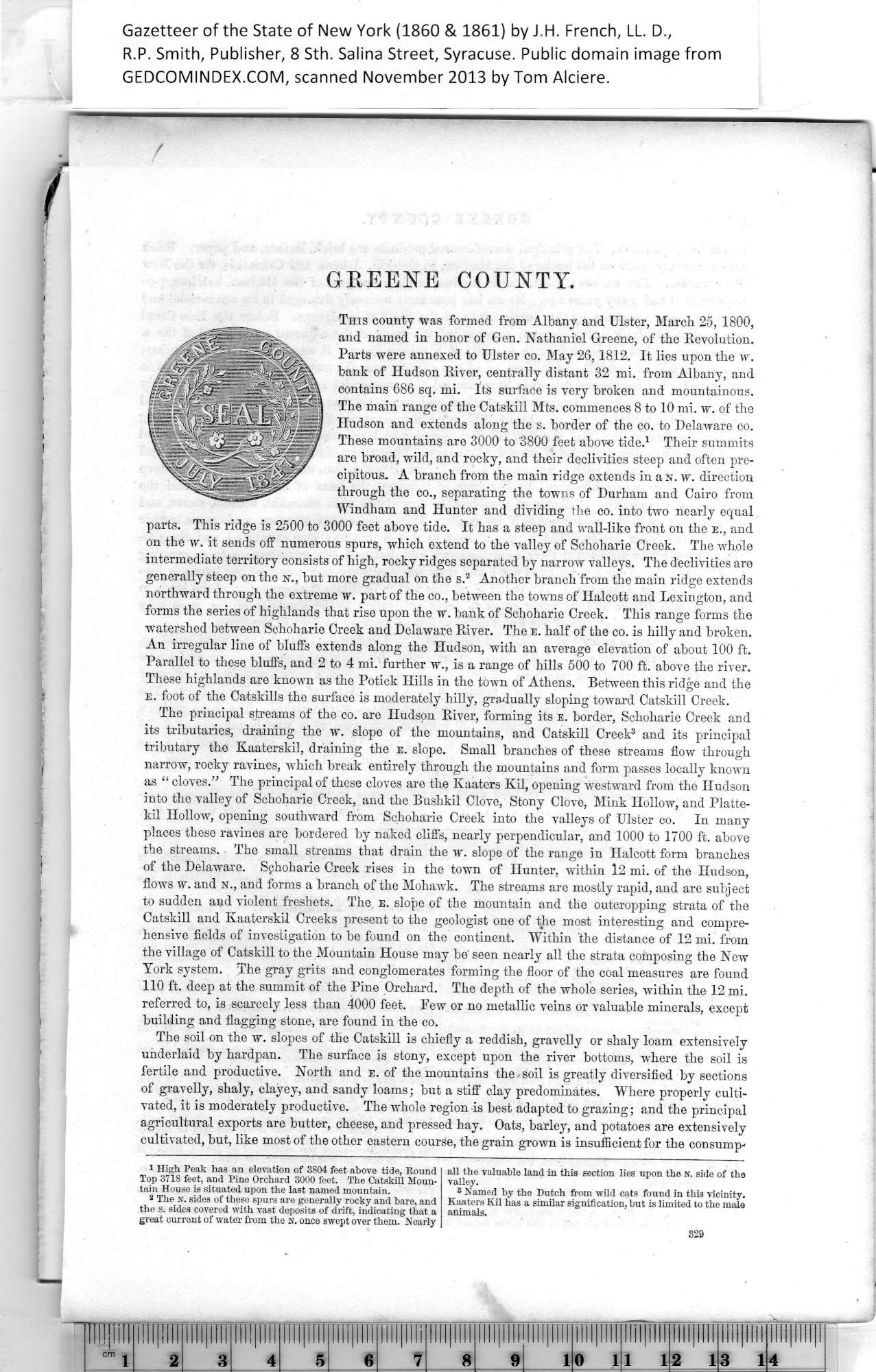|
GREENE COUNTY.
This county was formed from Albany and Ulster, March 25, 1800,
and named in honor of Gen. Nathaniel Greene, of the Revolution.
Parts were annexed to Ulster co. May 26,1812. It lies upon the w.
bank of Hudson River, centrally distant 32 mi. from Albany, and
contains 686 sq. mi. Its surface is very broken and mountainous.
The main range of the Catskiil Mts. commences 8 to 10 mi. w. of the
Hudson and extends along the s. border of the co. to Delaware co.
These mountains are 3000 to 3800 feet above tide.1 Their summits
are broad, wild, and rocky, and their declivities steep and often pre¬
cipitous. A branch from the main ridge extends in as. w. direction
through the co., separating the towns of Durham and Cairo from
Windham and Hunter and dividing the co. into two nearly equal
parts. This ridge is 2500 to 3000 feet above tide. It has a steep and wall-like front on the e., and
on the w. it sends off numerous spurs, which extend to the valley of Schoharie Creek. The whole
intermediate territory consists of high, rocky ridges separated by narrow valleys. The declivities are
generally steep on the n., but more gradual on the s.2 Another branch from the main ridge extends
northward through the extreme w. part of the co., between the towns of Halcott and Lexington, and
forms the series of highlands that rise upon the w. bank of Schoharie Creek. This range forms the
watershed between Schoharie Creek and Delaware River. The e. half of the co. is hilly and broken.
An irregular line of bluffs extends along the Hudson, with an average elevation of about 100 ft.
Parallel to these bluffs, and 2 to 4 mi. further w., is a range of hills 500 to 700 ft. above the river.
These highlands are known as the Potick Hills in the town of Athens. Between this ridge and the
e. foot of the Catskills the surface is moderately hilly, gradually sloping toward Catskiil Creek.
The principal streams of the co. are Hudson River, forming its e. border, Schoharie Creek and
its tributaries, draining the w. slope of the mountains, and Catskiil Creek3 and its principal
tributary the Kaaterskil, draining the e. slope. Small branches of these streams flow through
narrow, rocky ravines, which break entirely through the mountains and form passes locally known
as “ cloves.’1 The principal of these cloves are the Kaaters Kil, opening westward from the Hudson
into the valley of Schoharie Creek, and the Bushkil Clove, Stony Clove, Mink Hollow, and Platte-
kil Hollow, opening southward from Schoharie Creek into the valleys of Ulster co. In many
places these ravines are bordered by naked cliffs, nearly perpendicular, and 1000 to 1700 ft. above
the streams. The small streams that drain the w. slope of the range in Halcott form branches
of the Delaware. Schoharie Creek rises in the town of Hunter, within 12 mi. of the Hudson,
flows w. and n., and forms a branch of the Mohawk. The streams are mostly rapid, and are subject
to sudden and violent freshets. The e. slope of the mountain and the outcropping strata of the
Catskiil and Kaaterskil Creeks present to the geologist one of the most interesting and compre¬
hensive fields of investigation to be found on the continent. Within the distance of 12 mi. from
the village of Catskiil to the Mountain House may be' seen nearly all the strata composing the New
York system. The gray grits and conglomerates forming the floor of the coal measures are found
110 ft. deep at the summit of the Pine Orchard. The depth of the whole series, within the 12 mi.
referred to, is scarcely less than 4000 feet. Few or no metallic veins or valuable minerals, except
building and flagging stone, are found in the co.
The soil on the w. slopes of the Catskiil is chiefly a reddish, gravelly or shaly loam extensively
underlaid by hardpan. The surface is stony, except upon the river bottoms, where the soil is
fertile and productive. North and e. of the mountains the soil is greatly diversified by sections
of gravelly, shaly, clayey, and sandy loams; but a stiff clay predominates. Where properly culti¬
vated, it is moderately productive. The whole region is best adapted to grazing; and the principal
agricultural exports are butter, cheese, and pressed hay. Oats, barley, and potatoes are extensively
cultivated, but, like most of the other eastern course, the grain grown is insufficient for the consump-
|
all the valuable land in this section lies upon the n. side of the
valley.
3 Named by the Dutch from wild cats found in this vicinity.
Kaaters Kil has a similar signification, but is limited to the male
animals. |
1
High Peak has an elevation of 3804 feet ahove tide, Round
Top 3718 feet, and Pine Orchard 3000 feet. The Catskiil Moun¬
tain House is situated upon the last named mountain.
2
The n. sides of these spurs are generally rocky and bare, and
3
the s. sides covered with vast deposits of drift, indicating that a
great current of water from the n. once swept over them. Nearly
|
